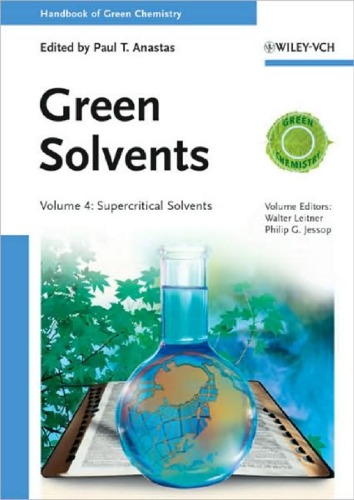

Most ebook files are in PDF format, so you can easily read them using various software such as Foxit Reader or directly on the Google Chrome browser.
Some ebook files are released by publishers in other formats such as .awz, .mobi, .epub, .fb2, etc. You may need to install specific software to read these formats on mobile/PC, such as Calibre.
Please read the tutorial at this link: https://ebookbell.com/faq
We offer FREE conversion to the popular formats you request; however, this may take some time. Therefore, right after payment, please email us, and we will try to provide the service as quickly as possible.
For some exceptional file formats or broken links (if any), please refrain from opening any disputes. Instead, email us first, and we will try to assist within a maximum of 6 hours.
EbookBell Team

4.7
106 reviews
ISBN 10: 3527688586
ISBN 13: 978-3527688586
Author: Paul Anastas, Walter Leitner, Philip Jessop
Green Chemistry is of crucial interest in a world where being as environmentally sound as possible is no longer a luxury but a necessity. Its applications include the design of chemical products and processes that help to reduce or eliminate the use and generation of hazardous substances.
This handbook comprises 12 volumes, divided into four subject-specific sets:
Set I: Green Catalysis
- Volume 1: Homogeneous Catalysis
- Volume 2: Heterogeneous Catalysis
- Volume 3: Biocatalysis
Set II: Green Solvents
Set III: Green Processes
Set IV: Green Products
Supercritical fluids (SCFs) and gas-expanded liquids (GXLs) are of great interest in green chemistry since they are either nontoxic and non-polluting solvents (such as carbon dioxide or water) or they help to avoid harmful intermediates through new processing routes. This book examines the use of SCFs and GXLs in catalysis, polymerization and many other major reactions and processes where it is crucial to avoid using hazardous solvents. The additional control parameters resulting from the unique physico-chemical properties of such solvents are discussed and highlighted along with numerous examples from the current literature and applications.
Chapter 1: Introduction
1.1 What is a Supercritical Fluid (SCF)?
1.2 Practical Aspects of Reactions in Supercritical Fluids
1.3 The Motivation for Use of SCFs in Modern Chemical Synthesis
1.4 The History and Applications of SCFs
References
Chapter 2: High-pressure Methods and Equipment
2.1 Introduction
2.2 Infrastructure for High-pressure Experiments
2.3 High-pressure Reactors
2.4 Auxiliary Equipment and Handling
2.5 Dosage Under a High-pressure Regime
2.6 Further Regulations and Control in Flow Systems
2.7 Evaporation and Condensation
2.8 Complete Reactor Systems for Synthesis with SCFs
2.9 Conclusion
References
Chapter 3: Basic Physical Properties, Phase Behavior and Solubility
3.1 Introduction
3.2 Basic Physical Properties of Supercritical Fluids
3.3 Phase Behavior in High-Pressure Systems
3.4 Factors Affecting Solubility in Supercritical Fluids
References
Chapter 4: Expanded Liquid Phases in Catalysis: Gas-expanded Liquids and Liquid–Supercritical Fluid Biphasic Systems
4.1 A Practical Classification of Biphasic Systems Consisting of Liquids and Compressed Gases for Multiphase Catalysis
4.2 Physical Properties of Expanded Liquid Phases
4.3 Chemisorption of Gases in Liquids and their Use for Synthesis and Catalysis
4.4 Using Gas-expanded Liquids for Catalysis
4.5 Why Perform Liquid–SCF Biphasic Reactions?
4.6 Biphasic Liquid–SCF Systems
4.7 Biphasic Reactions in Emulsions
References
Chapter 5: Synthetic Organic Chemistry in Supercritical Fluids
5.1 Introduction
5.2 Hydrogenation in Supercritical Fluids
5.3 Hydroformylation and Related Reactions in Supercritical Fluids
5.4 Oxidation Reactions in Supercritical Fluids
5.5 Palladium-mediated Coupling Reactions in Supercritical Fluids
5.6 Miscellaneous Catalytic Reactions in Supercritical Fluids
5.7 Cycloaddition Reactions in Supercritical Fluids
5.8 Photochemical Reactions in Supercritical Fluids
5.9 Radical Reactions in Supercritical Fluids
5.10 Biotransformations in Supercritical Fluids
5.11 Conclusion
References
Chapter 6: Heterogeneous Catalysis
6.1 Introduction and Scope
6.2 General Aspects of Heterogeneous Catalysis in SCFs and GXLs
6.3 Selected Examples of Heterogeneously Catalyzed Conversions in SCFs and GXLs
6.4 Outlook
References
Chapter 7: Enzymatic Catalysis
7.1 Enzymes in Non-aqueous Environments
7.2 Supercritical Fluids for Enzyme Catalysis
7.3 Enzymatic Reactions in Supercritical Fluids
7.4 Reaction Parameters in Supercritical Biocatalysis
7.5 Stabilized Enzymes for Supercritical Biocatalysis
7.6 Enzymatic Catalysis in IL–scCO2 Biphasic Systems
7.7 Future Trends
References
Chapter 8: Polymerization in Supercritical Carbon Dioxide
8.1 General Aspects
8.2 Polymerization in scCO2
8.3 Conclusion
References
Chapter 9: Synthesis of Nanomaterials
9.1 Introduction
9.2 Metal and Semiconductor Nanocrystals
9.3 Metal Oxide Nanoparticles
9.4 Carbon Nanomaterials
9.5 Nanocomposites
9.6 Conclusion
References
Chapter 10: Photochemical and Photo-induced Reactions in Supercritical Fluid Solvents
10.1 Introduction
10.2 Photochemical Reactions in Supercritical Fluid Solvents
10.3 Photo-initiated Radical Chain Reactions in Supercritical Fluid Solvents
10.4 Conclusion
References
Chapter 11: Electrochemical Reactions
11.1 Introduction
11.2 Electrochemical Methods
11.3 Analytes
11.4 Electrolytes
11.5 Electrochemical Cell and Supercritical Fluid Delivery System
11.6 Electrodes
11.7 Solvents
11.8 Applications
11.9 Conclusion and Outlook
References
Chapter 12: Coupling Reactions and Separation in Tunable Fluids: Phase Transfer-Catalysis and Acid-catalyzed Reactions
12.1 Introduction
12.2 Phase Transfer Catalysis
12.3 Near-critical Water
12.4 Alkylcarbonic Acids
12.5 Conclusion
References
Chapter 13: Chemistry in Near- and Supercritical Water
13.1 Introduction
13.2 Properties
13.3 Synthesis Reactions [1, 3–5]
13.4 Biomass Conversion
13.5 Supercritical Water Oxidation (SCWO)
13.6 Inorganic Compounds in NSCW
13.7 Conclusion
13.8 Future Trends
References
Index
handbook of green chemistry and technology pdf
handbook of green chemistry pdf
handbook of green analytical chemistry
handbook of green analytical chemistry pdf
handbook of chemistry and physics pdf
Tags: Paul Anastas, Walter Leitner, Philip Jessop, Green Chemistry, Supercritical Solvents